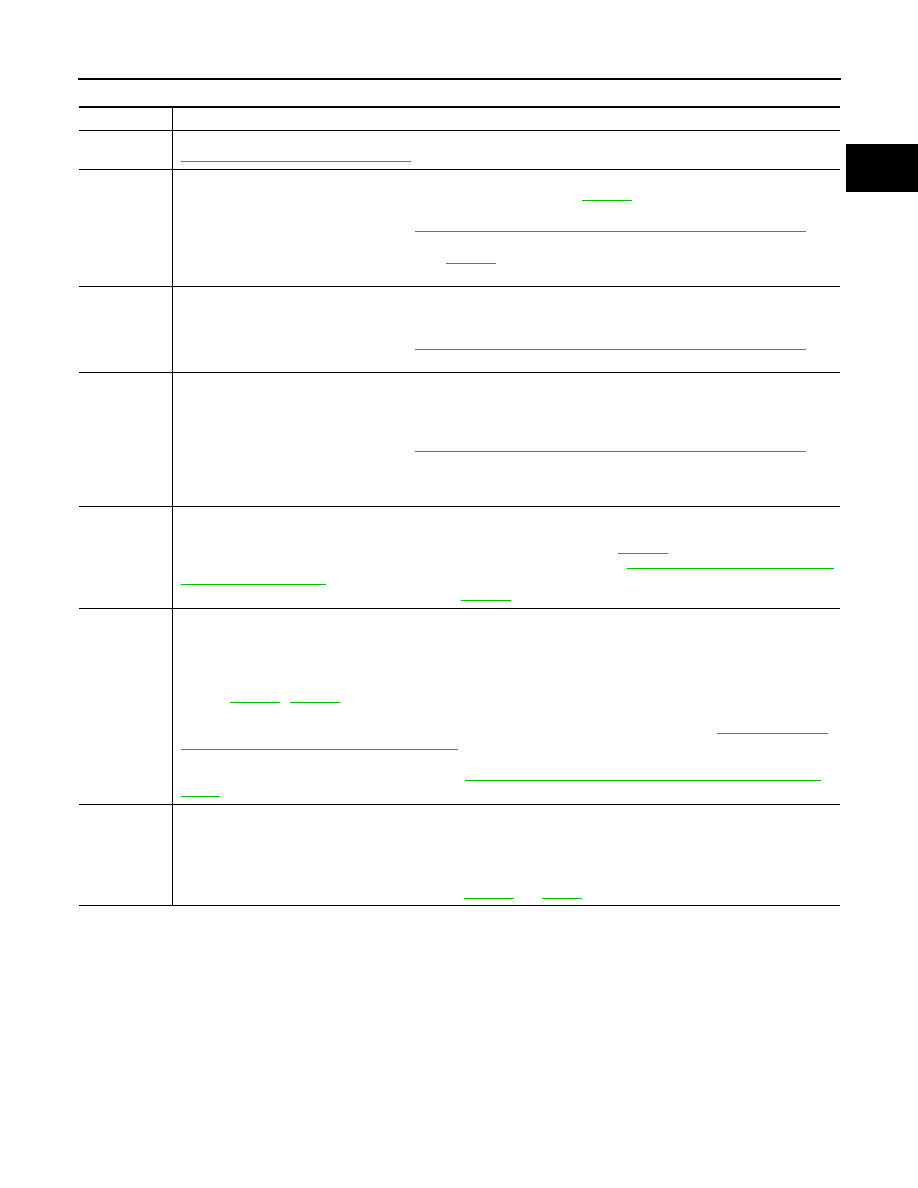Nissan Frontier D22. Manual - part 535

TROUBLE DIAGNOSIS
EC-1243
[VG33ER]
C
D
E
F
G
H
I
J
K
L
M
A
EC
Description For Work Flow
STEP
DESCRIPTION
STEP I
Get detailed information about the conditions and the environment when the incident/symptom occurred using the
EC-1244, "DIAGNOSTIC WORKSHEET"
.
STEP II
Before confirming the concern, check and write down (print out using CONSULT-II or GST) the (1st trip) DTC and the
(1st trip) freeze frame data, then erase the DTC and the data. (Refer to
.) The (1st trip) DTC and the (1st
trip) freeze frame data can be used when duplicating the incident at STEP III & IV.
If the incident cannot be verified, perform
EC-1297, "TROUBLE DIAGNOSIS FOR INTERMITTENT INCIDENT"
Study the relationship between the cause, specified by (1st trip) DTC, and the symptom described by the customer.
(The Symptom Matrix Chart will be useful. See
Also check related service bulletins for information.
STEP III
Try to confirm the symptom and under what conditions the incident occurs.
The DIAGNOSTIC WORK SHEET and the freeze frame data are useful to verify the incident. Connect CONSULT-II to
the vehicle in “DATA MONITOR (AUTO TRIG)” mode and check real time diagnosis results.
If the incident cannot be verified, perform
EC-1297, "TROUBLE DIAGNOSIS FOR INTERMITTENT INCIDENT"
If the malfunction code is detected, skip STEP IV and perform STEP V.
STEP IV
Try to detect the (1st trip) DTC by driving in (or performing) the DTC Confirmation Procedure. Check and read the (1st
trip) DTC and (1st trip) freeze frame data by using CONSULT-II or GST.
During the (1st trip) DTC verification, be sure to connect CONSULT-II to the vehicle in “DATA MONITOR (AUTO
TRIG)” mode and check real time diagnosis results.
If the incident cannot be verified, perform
EC-1297, "TROUBLE DIAGNOSIS FOR INTERMITTENT INCIDENT"
In case the DTC Confirmation Procedure is not available, perform the Overall Function Check instead. The (1st trip)
DTC cannot be displayed by this check, however, this simplified check is an effective alternative.
The NG result of the Overall Function Check is the same as the (1st trip) DTC detection.
STEP V
Take the appropriate action based on the results of STEP I through IV.
If the malfunction code is indicated, proceed to TROUBLE DIAGNOSIS FOR DTC PXXXX.
If the normal code is indicated, proceed to the BASIC INSPECTION. (Refer to
.) If CONSULT-II is available,
perform “DATA MONITOR (SPEC)” mode with CONSULT-II and proceed to the
. (If malfunction is detected, proceed to REPAIR/REPLACE.) Then perform inspections
according to the Symptom Matrix Chart. (Refer to
STEP VI
Identify where to begin diagnosis based on the relationship study between symptom and possible causes. Inspect the
system for mechanical binding, loose connectors or wiring damage using (tracing) Harness Layouts.
Gently shake the related connectors, components or wiring harness with CONSULT-II set in “DATA MONITOR (AUTO
TRIG)” mode.
Check the voltage of the related ECM terminals or monitor the output data from the related sensors with CONSULT-II.
Refer to
,
The Diagnostic Procedure in EC section contains a description based on open circuit inspection. A short circuit
inspection is also required for the circuit check in the Diagnostic Procedure. For details, refer to
form Efficient Diagnosis for an Electrical Incident"
Repair or replace the malfunction parts.
If malfunctioning part cannot be detected, perform
EC-1297, "TROUBLE DIAGNOSIS FOR INTERMITTENT INCI-
STEP VII
Once you have repaired the circuit or replaced a component, you need to run the engine in the same conditions and
circumstances which resulted in the customer's initial complaint.
Perform the DTC Confirmation Procedure and confirm the normal code [DTC No. P0000] is detected. If the incident is
still detected in the final check, perform STEP VI by using a different method from the previous one.
Before returning the vehicle to the customer, be sure to erase the unnecessary (already fixed) (1st trip) DTC in ECM
and TCM (Transmission control module). (Refer to
and